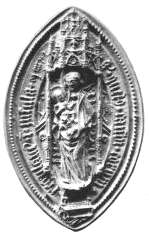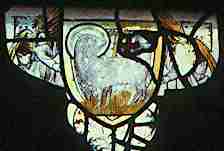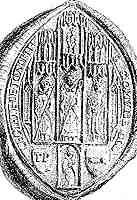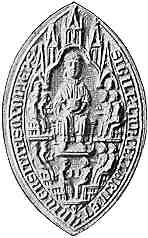 |
|
Seals
of Ecclesiastical Institutions (2) |
|
Ecclesiastical
seals could carry
religious motifs drawn directly from the repertoire of other forms of
church art. |
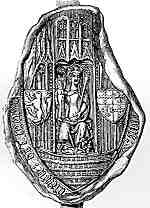 |
The
seal at left bears an image of the Virgin and child enthroned, a motif popular
with religious institutions. The Virgin sits beneath an architectural
canopy and is flanked by two shields of arms. At right, the Virgin stands holding the Child under a prominent and elaborate architecural canopy. |
|
|
At left the seal
of the chantry of Mettingham, Suffolk, from the early 15th century. At right the seal of the Convent of Canons Regular of Lille, in French Flanders, from 1411. |
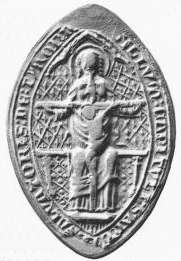 |
The seal at left shows a standard medieval depiction of the Holy Trinity, as befits the dedication of the abbey concerned, with the Father supporting the crucified Christ and the Holy Spirit as a dove emanating from his mouth. At right is a similar composition on the side of an alabaster tomb chest. Unfortunately the dove seems to have suffered loss over the centuries. |
|
| At left the seal of the Benedictine abbey of the Holy Trinity in Thiron, or Tiron, diocese of Chartres, France, from 1391. At right a carving from the alabaster tomb chest of Robert Waterton, d.1424, in the parish church of Methley in Yorkshire.. |
 |
The symbol of the lamb and flag, or agnus dei, for Christ is found in medieval art representations in many different media. It is also found as an attribute of John the Baptist. |
|
| At left, a 13th century seal of the convent of Friars Minor, or Franciscans, from either Moirent or Moirans in France. At right, the same motif in a 15th century stained glass window in Thornhill, Yorkshire. |
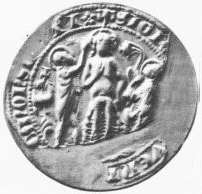 |
Episodes from the Bible could be depicted on ecclesiastical seals. The example at left shows the baptism of Christ by John the Baptist in the River Jordan. The abbey which owned the seal was the original house of the Premonstratensian order. |
| Seal of the abbey of Prémontré, in the diocese of Laon, France. The seal is attached to a document of 1286, but has been made from a 12th century matrix. |
| Seals could even be drawn from religious mythology. The example at right depicts St Vigor, bishop of Bayeux, holding a chained dragon with one hand and piercing it with a lance with the other. They must have had some pretty exciting times there in Bayeux before they all settled down and took up embroidery. |
|
| Seal of the Benedictine abbey of St Vigor at Cérisy in the diocese of Bayeax, of c.1222. |
|
As
designs became more elaborate, they adopted certain features derived from
architecture. The seal at right has three figures of saints under architectural
canopies. It is intriguing that an art form so minute and intricate could
receive inspiration from another so large and monumental. The figures
are arranged in similar manner to sculpted stone figures on facades, screens
or funerary monuments. |
|
|
Seal
with figures of saints, of the College of Tanworth. |
|
The
examples shown indicate that seals of ecclesiastical institutions could
be either round or pointed oval. Only the most elaborate, such as that
of Westminster Abbey, were double sided, but sometimes a smaller counterseal
was used on the reverse. |
|
In
this general category one might also consider the universities, as they
were originally founded to educate the clergy and their seals carry similar
iconographic representations. |
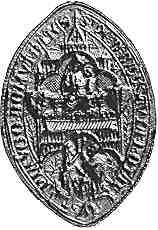 |
The
first seal of Balliol College shows the founders, John de Balliol and
his wife Dervorguilla, kneeling and holding shields of arms with one hand
(impossible to distinguish here) while with the other they support a model
of the college buildings. The Virgin sits enthroned within the building,
indicating the dedication of the college. |
|
First
seal of Balliol College, Oxford. |
|
The
seal of Oxford University itself depicts a group of academics under an
architectural canopy that suggests that the vision of dreaming spires
goes back quite a long way. It represents the chancellor of the university
presiding over a disputation. It's nice to know that nothing much has
changed in universities in over 700 years. |
|
|
The
first seal of the University of Oxford, from the 13th century. |
 previous
page previous
page |
 Seals Seals |
 Decoration Decoration |
|
 |
 |
 |
 |
 |
 |
 |
 |
 |
 |

